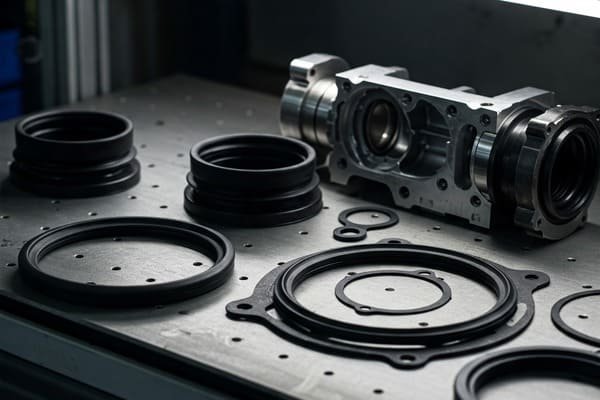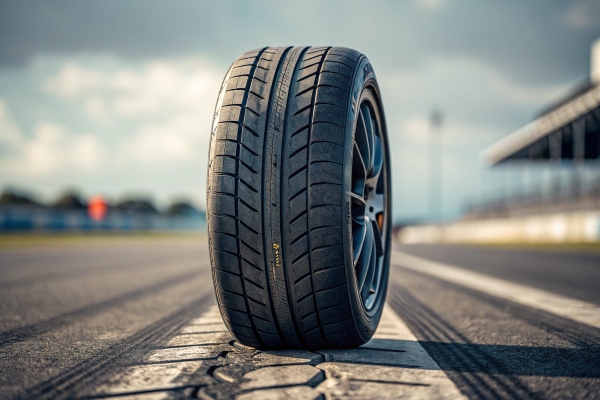Curious about the applications of polybutadiene rubber? Polybutadiene rubber (BR) is a synthetic rubber with unique properties that make it ideal for several industrial uses. Let’s explore where and how this versatile material is commonly applied.
Polybutadiene rubber is primarily used in the automotive industry for tires, as well as in products like seals, gaskets, and elastomers due to its excellent wear resistance and low rolling resistance.

Polybutadiene rubber's properties, such as its high elasticity, durability, and low rolling resistance, make it suitable for a wide range of applications. Let’s take a closer look at the various industries where polybutadiene is commonly used.
What Is Polybutadiene Rubber?
Before we dive into its uses, it's important to understand what polybutadiene rubber is and how it compares to other types of rubber.
Polybutadiene rubber is a synthetic elastomer made from polymerizing butadiene monomers. It is known for its high resilience, low temperature flexibility, and excellent abrasion resistance.
Polybutadiene rubber1 is a synthetic rubber produced through the polymerization of butadiene, a type of hydrocarbon. It is commonly used in the automotive industry due to its durability, low rolling resistance, and excellent wear resistance. Polybutadiene is also one of the key ingredients in the production of tire treads, making it a critical material in the tire manufacturing process2.
Polybutadiene rubber is often blended with other types of rubber, such as styrene-butadiene rubber (SBR)3, to enhance its properties and optimize performance. Its primary benefits include high elasticity, resistance to wear, and good aging properties, making it ideal for products subjected to constant use and friction.
| Property | Polybutadiene Rubber | Key Applications |
|---|---|---|
| Elasticity | High | Tires, elastomers |
| Abrasion Resistance | Excellent | Tires, industrial products |
| Cold Flexibility | Low temperature flexibility | Automotive, seals, gaskets |
✅ Why it matters:
Understanding the basic properties of polybutadiene rubber allows you to better appreciate its applications in the automotive and manufacturing industries.
What Is the Common Name for Polybutadiene?
You might have heard polybutadiene referred to by another name. Let’s explore its common name and why it is so frequently used in various industries.
Polybutadiene is commonly known as BR (butadiene rubber) and is widely used in the automotive and manufacturing industries, particularly for tire production.
Where Is Polybutadiene Made?
Ever wondered where polybutadiene rubber is produced? Let’s explore the main regions and industries involved in its production.
Polybutadiene is primarily produced through the polymerization of butadiene, with major production facilities located in countries with strong petrochemical industries like the United States, China, and Europe.
Common Applications of Polybutadiene Rubber
What are the primary uses of polybutadiene rubber in the industrial world? Let’s take a closer look at where this versatile material is put to work.
Polybutadiene rubber is used in manufacturing tires, as well as in industrial applications like seals, gaskets, and belts due to its wear resistance, flexibility, and low rolling resistance.
Polybutadiene rubber is widely used in a range of industrial applications, particularly in the automotive and manufacturing sectors. Here are some of its most common uses:
1. Tire Manufacturing
Polybutadiene rubber is one of the primary ingredients in tire manufacturing4, particularly in tire treads. It is favored for its excellent wear resistance, which helps extend tire lifespan, and its low rolling resistance, which enhances fuel efficiency in vehicles.
- Best For: High-performance tires, passenger vehicle tires, industrial tires.
- Advantages: High durability, wear resistance, and low rolling resistance.
- Applications: Tires, tire treads, and sidewalls.
2. Seals and Gaskets
Due to its high elasticity and resistance to aging and wear, polybutadiene rubber is also used in seals and gaskets5, especially in automotive and industrial machinery. It maintains its sealing properties under pressure and environmental conditions, making it ideal for long-lasting seals.
- Best For: Automotive seals, industrial machinery seals.
- Advantages: Excellent resistance to oils, water, and weathering.
- Applications: Valve seals, O-rings, gaskets.
3. Industrial Products
Polybutadiene is used in a variety of industrial products6 that require high resilience and durability, such as belts, hoses, and conveyor rollers. Its wear resistance ensures that these products remain functional under continuous mechanical stress.
- Best For: Belts, hoses, rollers, and industrial gaskets.
- Advantages: Good abrasion resistance and mechanical strength.
- Applications: Manufacturing equipment, conveyor systems.
4. Elastomers
Polybutadiene is often used in the production of elastomers, where it is blended with other materials to improve elasticity, tear strength, and chemical resistance. These elastomers are used in automotive parts, machinery, and consumer goods.
- Best For: Automotive and machinery components, consumer products.
- Advantages: High flexibility, chemical resistance.
- Applications: Automotive bushings, vibration dampers, and more.
| Application Type | Polybutadiene Rubber Performance | Common Products |
|---|---|---|
| Tires | High wear resistance, low rolling resistance | Passenger vehicle tires, industrial tires |
| Seals & Gaskets | Excellent elasticity and aging resistance | Valve seals, O-rings, gaskets |
| Industrial Products | Excellent wear resistance, durability | Belts, hoses, rollers |
| Elastomers | High elasticity, chemical resistance | Automotive parts, machinery components |
✅ Why it matters:
Knowing the specific uses of polybutadiene rubber helps you select the right material for your application, ensuring longevity and performance in harsh environments.
What Makes Polybutadiene Rubber Ideal for Tire Manufacturing?
What makes polybutadiene rubber such an ideal material for tire manufacturing? Let’s explore its role in the production of tires and how it benefits the tire industry.
Polybutadiene rubber is favored in tire manufacturing for its excellent abrasion resistance, flexibility, and low rolling resistance, which enhances both the durability and fuel efficiency of tires.

Polybutadiene rubber plays a crucial role in tire manufacturing, especially in the tread compound. Tires are subject to constant wear, high pressure, and extreme temperatures, which means the materials used must have excellent durability and resistance to abrasion. Polybutadiene’s high resilience makes it ideal for this purpose, allowing the tire to maintain its shape and performance over time.
Key Benefits of Polybutadiene in Tires:
- Wear Resistance7: Polybutadiene’s ability to withstand wear and tear improves tire longevity.
- Low Rolling Resistance8: This contributes to better fuel efficiency, making vehicles more energy-efficient.
- Elasticity9: Polybutadiene enhances the tire’s ability to deform and recover, providing a smooth ride.
By blending polybutadiene with other rubber materials like styrene-butadiene rubber (SBR), manufacturers can create a tire compound that balances wear resistance, flexibility, and fuel efficiency.
| Tire Performance Aspect | Polybutadiene Rubber Benefits | How It Helps Tires |
|---|---|---|
| Wear Resistance | Excellent | Extends tire lifespan |
| Rolling Resistance | Low | Improves fuel efficiency |
| Elasticity | High | Enhances ride comfort |
✅ Why it matters:
Polybutadiene’s role in tire manufacturing enhances vehicle performance, reducing fuel consumption and increasing tire durability—making it a top choice for automotive and industrial tires.
How Do You Make Polybutadiene Rubber?
How is polybutadiene rubber made, and what is the process behind its creation? Let’s take a look at the steps involved in producing polybutadiene.
Polybutadiene rubber is made through the polymerization of butadiene monomers in a controlled process that results in a highly elastic, wear-resistant material used in tire manufacturing and other products.

Is Polybutadiene Biodegradable?
Wondering if polybutadiene is biodegradable? Let’s dive into its environmental impact and the longevity of this material.
Polybutadiene is not biodegradable, which raises concerns for its environmental impact, especially in waste disposal. It can take hundreds of years to break down in landfills.
Is Butadiene Rubber Safe?
How safe is butadiene rubber, especially when used in consumer products and automotive applications? Let’s explore the safety considerations surrounding polybutadiene.
Polybutadiene rubber is generally safe to use in many applications, but exposure to certain chemicals during the manufacturing process may pose health risks, so proper handling and safety protocols are important.
Conclusion
Polybutadiene rubber is an essential material used in various industries, particularly in tire manufacturing, seals, and gaskets. Its excellent wear resistance, flexibility, and low rolling resistance make it ideal for automotive applications. Whether you're looking for durable tires, reliable seals, or resilient industrial components, polybutadiene offers a versatile solution.
🚀 Need Custom Polybutadiene Rubber Products?
Contact Julong Rubber today or Request a Custom Quote for high-quality polybutadiene rubber solutions tailored to your specifications!
Or reach out to us directly via WhatsApp:
-
Explore this link to gain a deeper understanding of Polybutadiene rubber's unique properties and its vital role in various industries. ↩
-
Learn about the tire manufacturing process and how Polybutadiene rubber contributes to tire performance and durability. ↩
-
Discover the benefits and applications of SBR, a key material often blended with Polybutadiene rubber for enhanced performance. ↩
-
Explore how polybutadiene rubber enhances tire performance and longevity, making it a crucial material in the automotive industry. ↩
-
Learn about the advantages of polybutadiene rubber in creating durable and effective seals and gaskets for various machinery. ↩
-
Discover the diverse uses of polybutadiene rubber in industrial settings, ensuring durability and resilience in demanding environments. ↩
-
Understanding wear resistance can help you appreciate how polybutadiene enhances tire longevity and performance. ↩
-
Exploring this topic reveals how tire design impacts energy consumption and vehicle efficiency. ↩
-
Learning about elasticity can enhance your knowledge of tire technology and its effects on driving experience. ↩









